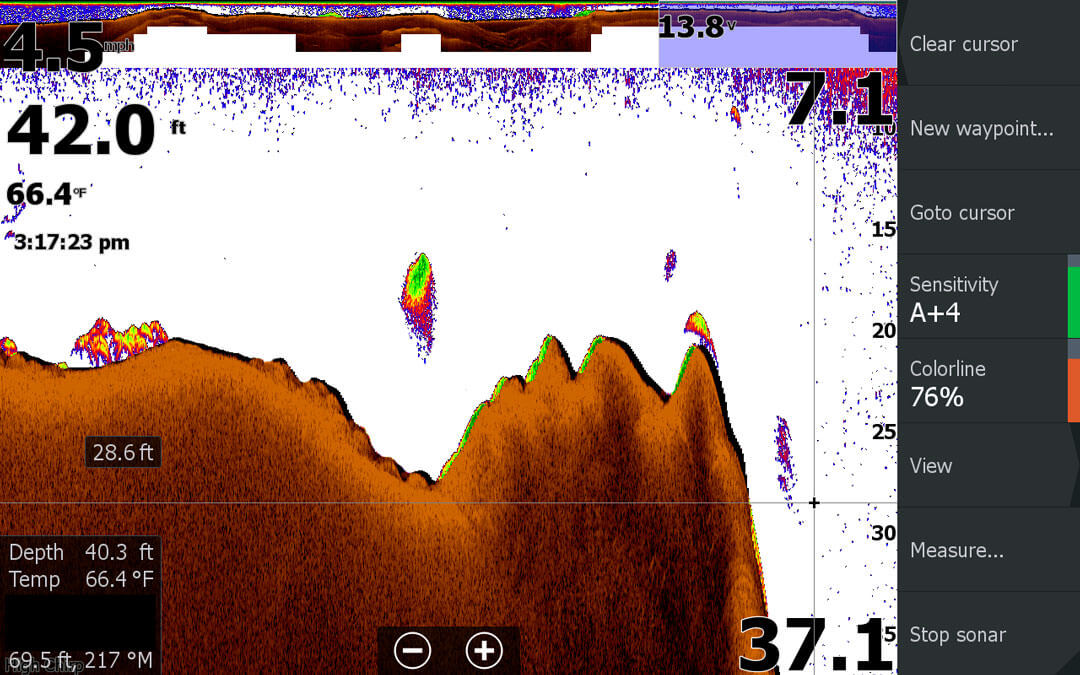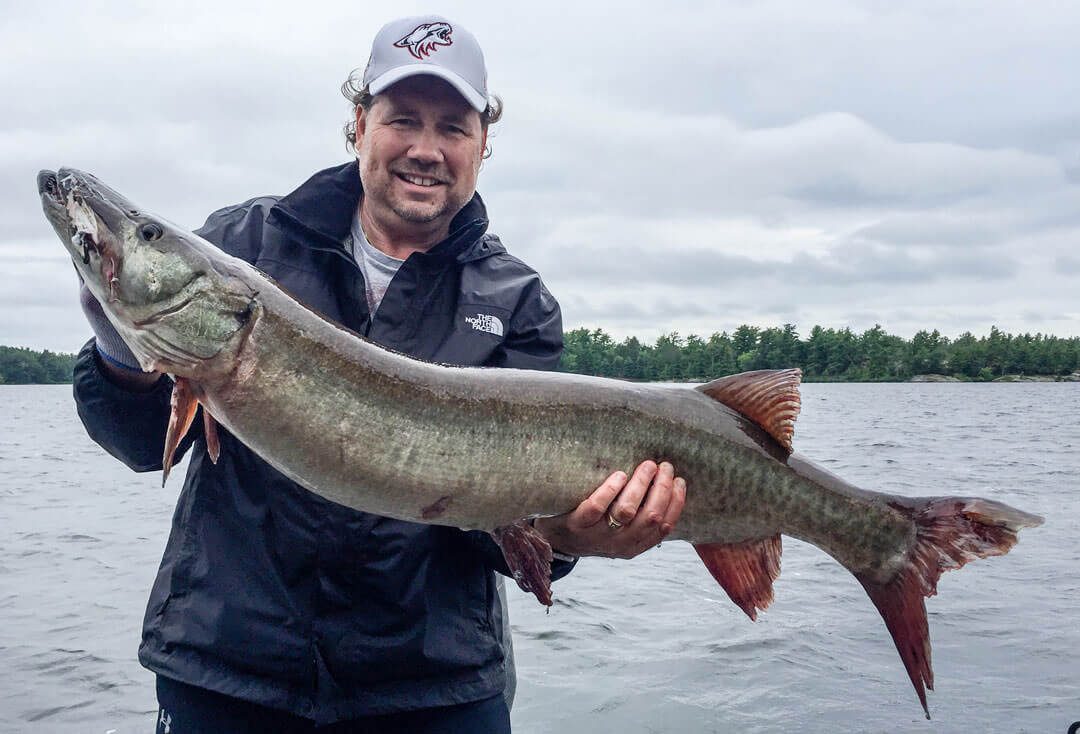by Pat Tryon
Increase your odds and expand your knowledge… hire a guide!
Find a musky guide in your area with our Trip Planner.
Know a guide that should be on our map? Make a suggestion.
Assuming you are able to identify a musky (or sometimes large northern pike), you can begin to analyze each musky you mark on your electronics, and better understand the mood of each fish. I take screenshots constantly on the water and I jot down notes so that I can compare them later. With the technology of my Lowrance sonar, I can see a musky in virtually any situation, and then quickly grab a screenshot for comparing and analyzing. Regardless of your brand, make sure you spend time adjusting your settings to ensure you are seeing everything going on below the boat.
In my experience, the single most important piece of information that suggests the “attitude” of a musky on your sonar is the position of the fish in relation to the structure and bait surrounding her. Since we can’t physically see the fish as we can when casting, we need to make some general assumptions based on where that fish is choosing to position herself.
Sometimes we can immediately go back over a spot where we have seen a musky and see it again, which helps refine the activity level of an individual fish. While this is incredibly valuable for triggering a strike on that particular musky, I find that utilizing the information from seeing a single musky is often the take-away for patterning the population as a whole. Obviously marking a single fish is a great indicator of an area to revisit during what might be a more productive time of the day (i.e. majors, minors, or approaching low pressure storms). The aim of this article however is to break down the picture we are seeing on our sonar to influence our own decisions and tactics on the water in the present, in order to trigger bites from other fish that are likely acting in a similar fashion.
Under normal circumstances, I will almost always make a second pass on any musky I mark on the sonar. If I go back over the spot and she remains in the same depth at the same location, I make note of the location to revisit during a more “productive time”, but I assume this fish is not a biter and continue covering water. Spending a great amount of time on this particular fish may actually do more harm than good, as you can condition her to your boat noise and baits which may ultimately spook the musky. I find it’s best to move on.

If you mark a fish on your sonar this close to structure, it is critical to make sure at least one lure is hitting the depth within a foot or two above that fish, and never below the fish! In the event you are fishing in a relatively featureless body of water, the baitfish becomes “the structure”, and canvassing the area with your bait at the same depth or slightly above can result in success.


I look for the sharpest break near the deepest water as a prime spot. Alternatively, the highest point on a piece of structure can commonly be “the spot”, as a musky will use this position to see everything going on around her. When we mark a fish in these areas, the rod often goes off as we make our first pass so long as we have a lure close to this fish. I have seen fish rise up 20 feet or more to eat a lure above, but my goal is to have an offering within five feet of these fish.
If you notice a fish sitting on one of these prime areas, ensure you have a bait as close as possible to that fish, again, making sure the bait is not below the musky. Even if the fish does not bite on the first trolling pass, you can often go back over the fish and encourage a strike by changing up your baits and/or spread. For instance, if you see a fish sitting on a ledge 20 feet down near deep water, but your deepest bait is only down 10 feet, you may want to try dropping a bait down 20 feet, with a second bait further behind the boat in 15 feet. Understanding and fine-tuning your lure spread will help trigger strikes in these scenarios.

Often, following your gut instinct may be the only way to trigger a strike. Pushing your own comfort level and trying tactics you may have never tried before may be exactly what it takes to progress as an angler and find success in tough bites. This was the case on one my personal favorite fish. It was certainly not the biggest musky, but the details surrounding the catch made this a great memory.

Increase your odds and expand your knowledge… hire a guide!
Find a musky guide in your area with our Trip Planner.
Know a guide that should be on our map? Make a suggestion.
Upon first glance, this was not an “active fish”. I was also at the end of a trolling run where I had seen no walleye or perch, and no baitfish other than very small clouds of shiners sparsely spread around the area. I was ready to pull the lines and go look for more bait when I realized that the best bait I had seen in the entire area was directly in front of that musky!
Something just clicked and told me I needed to get a lure that looked like a walleye down to her level. I snapped on a 12” Blue Water Herring Bait in a Hot Walleye pattern, as I knew this bait could easily reach 25 feet deep. I followed this up with two other offerings getting down 20 and 12 feet deep, in the event that she had pulled off bottom after our first pass. Then, I followed my boat trail on the Lowrance back toward the fish, and about 100 feet before we got to the icon that I used to mark her location, the reel screamed and we had her.
To this day I often think about how close I had been to pulling all the lines and getting out of there. Taking that extra second to think about what I was actually looking at put the only fish of the day in the boat, and made for an extremely happy client!

Pat Tryon is the head guide at Chaudière Lodge.
Making small adjustments to your presentation while trolling for musky will often pay off big to those who are paying attention. Keep detailed notes of the changes you make for each given scenario and over time you will see your catch rates increase dramatically. In the pursuit of the biggest fish, it is often the smallest details that matter most.
What small details do you pay attention to when trolling for musky? Chime in with your comments below.
– Pat Tryon
Pat Tryon is the head guide at Chaudière Lodge.







Love Pats article. Reviewing sonar readings was the best. When I’m trolling my eyes are glued to my sonar and chart plotter.
We’re glad you liked it Gerry! We had a sneaking suspicion the sonar readings would go over well but it’s great to hear it from readers – thanks for chiming in.
Enjoyed your article but not totally convinced about the never having lures below the fish. Muskies feed on many bottom dwelling species bullheads,suckers, walleye and others that spend the majority of their time on bottom. Have caught many fish scratching the bottom with a deep diving crank bait. I also believe in river situations muskies relate to the bottom or shoreline because of the current
Hi Frank!
Thank you for reading and thinking critically about the article. I certainly agree with you, as we get a lot of Muskies every year near bottom. When I said in the article to not have your bait below the fish, I am referring to a fish you have marked on your sonar already. If you see a fish in 15 feet of water over 30 feet, you want to have your bait down 10-15 feet, not down 30 in that situation. Even if you keep a line down deeper then the fish, you have to make sure at least one of your lines is at the level of the fish, or slightly shallower. I am not saying to have all baits above the fish for all trolling situations.
Thanks for reading and your comment!
-Pat Tryon